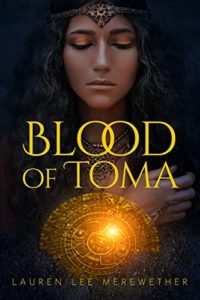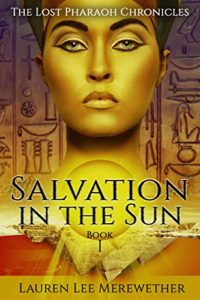
Lauren Lee Merewether: Salvation in the Sun
 My guest today is Lauren Lee Merewether
My guest today is Lauren Lee Merewether
A fellow student at the Self Publishing School and an avid participant in its sister school, Self-Publishing School – Fundamentals of Fiction.
On 22 May, Lauren is launching her latest historical fiction book Salvation in the Sun, the first book in the series, The Lost Pharaoh Chronicles.
It’s on sale at Amazon US for $1.34 and at Amazon UK for 99p. However, it is free for two days: 20/21 May.
Salvation in the Sun has already received a five-star review from Readers’ Favorite, and Lauren and I are looking forward to seeing how it does on the Amazon Kindle Store.
Tell us about your first book: Blood of Toma
 Blood of Toma received a finalist designation for the Montaigne Medal awarded to the most thought-provoking novel as a part of the Eric Hoffer Award. It also won one of five Finalists spots for the Next Generation Indie Book Award in Historical Fiction.
Blood of Toma received a finalist designation for the Montaigne Medal awarded to the most thought-provoking novel as a part of the Eric Hoffer Award. It also won one of five Finalists spots for the Next Generation Indie Book Award in Historical Fiction.
How did Scrivener make writing easier for you?
In writing Blood of Toma, I used Word. All of the notes and web URLs for research were tracked in Word Comments. I deleted each one when I didn’t need it anymore, and key items were captured in a notebook.
I don’t recommend that approach! It was time-consuming and talk about scrolling through 300 pages of comments to find that one fact about that one place – yick. AND once it was deleted, it was gone and I had no easy way of finding that resource again unless I wanted to repeat the hours of research.
After that book, I took a break, just because it had taken so long to write. Then a few years later, I heard a friend was using Scrivener to write her book and she loved its organizational capability. So, I thought, for $45, I’ll buy Scrivener 2 for my Mac, and wow, it made research and keeping facts straight so much easier which, of course, sped up my writing productivity.
I then upgraded to Scrivener 3 because I’m a techie at heart – I finished out the book in Scrivener 3 but most everything I did for the book was in Scrivener 2.
 Just to show you how much time Scrivener saved – I wrote Blood of Toma in two years, and I wrote Salvation in the Sun in four months and was able to send it off to the editor before the holidays!
Just to show you how much time Scrivener saved – I wrote Blood of Toma in two years, and I wrote Salvation in the Sun in four months and was able to send it off to the editor before the holidays!
How did you go about collecting research for Salvation in the Sun?
After researching and finding good comprehensive websites, I would drag and drop the most useful website into Scrivener under the right ‘Place’, ‘Person’ or ‘Customs’ folder I had created in the Research section of the Scrivener Binder. Then I wrote a summary of what I found on that site (and other sites, if needed). In this way, I could see the summary for each website on the Corkboard view at a higher level.
Then, at the highest level such as ‘Place’, ‘Person’ or ‘Customs’, I could see my overall summary of the place or character and write my story in the place/character template and refer back to the specific website for more information if I needed it.
I love that I didn’t have to delete the information. It was all there and the webpage could be accessed offline if needed.
I also loved having it there when I crafted my year-long supply of Freebies which I give to my readers through my Exclusive Reader Offer located in each of my books.
With all the facts in place and easily referenced, I created the story timeline to fit within the historical facts and mainstream theories.
Any particular Scrivener features help you with keeping to the timeline?
Having the timeline and Scrivener’s ability to move scenes around was invaluable to my writing, especially to make sure the story followed the timeline.
I also love Scrivener’s multi-folder feature in the Binder. I constructed my story to have the setup, then the jumping off point, then events leading up to the first obstacle, second, third, then the climax and, finally, the resolution. With these folders already in the Binder, I was able to add the chapters and scenes to each, and I would simply write a few notes about what would happen in that scene. Then, I could see it again on the Corkboard view, and I could tag it as a certain person’s perspective since the book is written in third-person.
Scrivener helped me to keep scenes straight and focused, as well as providing a high-level overview of the timeline during review and planning.
I believe just having that level of organization, drill down and ease of moving things around made writing a historical fiction story so much easier than when I wrote my first book with Word.
What else is on the horizon for you?
I have already started Secrets in the Sand, the second book in The Lost Pharaoh Chronicles series. It is so much easier to write and keep track of what is in my head in my Scrivener binder. I am hoping to publish it next year and then the third book, Silence in the Stone, will be released in 2020.
More about Lauren
Lauren Lee Merewether is a young adult historical fiction author who loves to dive into history and find overlooked, under-appreciated and relatively unknown tidbits of our past. She then crafts engaging stories for her readers, with characters who love and lose, fights wrong with right, and hope in times of despair.
Lauren resides with her husband, Mark, in Texas. They are expecting their first child this year and couldn’t be happier!
You can contact Lauren via her website, or on Facebook or Twitter. She also has Facebook pages for her books: Blood of Toma and Lost Pharaoh Chronicles.
If you write using Scrivener (or even if you don’t!)
and would like to have a guest blog, contact me!
The ScrivenerVirgin blog is a journey of discovery:
a step-by-step exploration of how Scrivener can change how a writer writes.
To subscribe to this blog, click here.
Also … check out the Scrivener and RedPen Editing Tips
on my ScrivenerVirgin Facebook page.


No Comments